| 63rd Wisconsin Legislature | |||||
|---|---|---|---|---|---|
| |||||
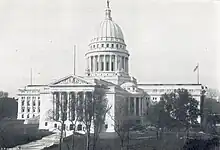 Wisconsin State Capitol ca.1915 | |||||
| Overview | |||||
| Legislative body | Wisconsin Legislature | ||||
| Meeting place | Wisconsin State Capitol | ||||
| Term | January 4, 1937 – January 2, 1939 | ||||
| Election | November 3, 1936 | ||||
| Senate | |||||
| Members | 33 | ||||
| Senate President |
| ||||
| President pro tempore | Walter J. Rush (P) | ||||
| Party control | Progressive | ||||
| Assembly | |||||
| Members | 100 | ||||
| Assembly Speaker | Paul Alfonsi (P) | ||||
| Party control | Progressive | ||||
| Sessions | |||||
| |||||
| Special sessions | |||||
| |||||
The Sixty-Third Wisconsin Legislature convened from January 13, 1937, to July 2, 1937, in regular session, and reconvened in a special session from September 15, 1937, to October 16, 1937.[1]
This was the high water mark for the power of the Wisconsin Progressive Party, as they controlled both chambers of the Legislature and the Governor's office.
Senators representing even-numbered districts were newly elected for this session and were serving the first two years of a four-year term. Assembly members were elected to a two-year term. Assembly members and even-numbered senators were elected in the general election of November 3, 1936. Senators representing odd-numbered districts were serving the third and fourth year of a four-year term, having been elected in the general election of November 6, 1934.[1]
Major events
- January 4, 1937: Third inauguration of Philip La Follette as Governor of Wisconsin.
- January 20, 1937: Second inauguration of Franklin D. Roosevelt as President of the United States. The first presidential inauguration to take place on January 20.
- May 6, 1937: The commercial airship LZ 129 Hindenburg was destroyed in an accidental fire while attempting to dock at Naval Air Station Lakehurst, in New Jersey, killing 35 passengers and crew.
- July 7, 1937: The Marco Polo Bridge Incident between forces of the Empire of Japan and the Republic of China, ignited the Second Sino-Japanese War.
- July 22, 1937: The United States Senate rejected U.S. President Franklin Roosevelt's proposal to add seats to the United States Supreme Court.
- October 16, 1937: Wisconsin lieutenant governor Henry Gunderson resigned.
- March 13, 1938: German leader Adolf Hitler declared the annexation of Austria.
- May 16, 1938: Herman Ekern was appointed lieutenant governor of Wisconsin to fill the vacancy caused by the resignation of Henry Gunderson.
- September 29, 1938: The Munich Agreement was signed by German, Italian, French, and British delegates, resolving the Sudetenland crisis by allowing Germany to annex the contested territory from Czechoslovakia.
- November 8, 1938: 1938 United States general election:
- Julius P. Heil (R) elected Governor of Wisconsin.
- Alexander Wiley (R) elected United States senator from Wisconsin.
- November 9, 1938: Nazi activists in Germany engaged in a nationwide riot against Jewish businesses and religious spaces, known as Kristallnacht.
- December 17, 1938: Otto Hahn discovered the nuclear fission of Uranium.
Major legislation
- 1937 Act 51: Created the Wisconsin Labor Relations Board.
Party summary
Senate summary
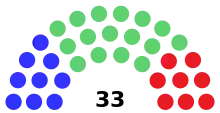
| Party (Shading indicates majority caucus) |
Total | ||||
|---|---|---|---|---|---|
| Dem. | Prog. | Rep. | Vacant | ||
| End of previous Legislature | 14 | 13 | 6 | 33 | 0 |
| Start of Reg. Session | 9 | 16 | 8 | 33 | 0 |
| Final voting share | 27.27% | 48.48% | 18.18% | ||
| Beginning of the next Legislature | 6 | 11 | 16 | 33 | 0 |
Assembly summary
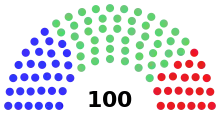
| Party (Shading indicates majority caucus) |
Total | |||||
|---|---|---|---|---|---|---|
| Dem. | Soc. | Prog. | Rep. | Vacant | ||
| End of previous Legislature | 35 | 3 | 43 | 17 | 98 | 2 |
| Start of Reg. Session | 31 | 0 | 48 | 21 | 100 | 0 |
| From May 30, 1937[note 1] | 20 | 99 | 1 | |||
| Final voting share | 31.31% | 48.48% | 20.2% | |||
| Beginning of the next Legislature | 15 | 0 | 32 | 53 | 100 | 0 |
Sessions
- Regular session: January 13, 1937 – July 2, 1937
- September 1937 special session: September 15, 1937 – October 16, 1937
Leaders
Senate leadership
- President of the Senate: Henry Gunderson (P) (resigned Oct. 16, 1937)
- Herman Ekern (P) (appointed May 16, 1938)
- President pro tempore: Walter J. Rush (P–Neillsville)
Assembly leadership
Members
Members of the Senate
Members of the Senate for the Sixty-Third Wisconsin Legislature:[2]
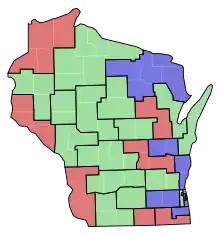
Members of the Assembly
Members of the Assembly for the Sixty-Third Wisconsin Legislature:[2]
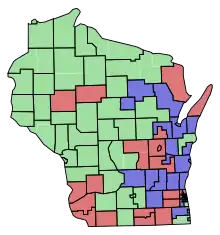
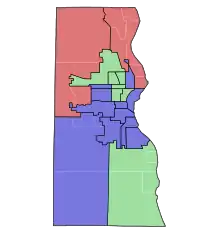
Committees
Senate committees
- Senate Standing Committee on Agriculture and Labor – J. E. Leverich, chair
- Senate Standing Committee on Committees – E. M. Rowlands, chair
- Senate Standing Committee on Contingent Expenditures – R. E. Kannenberg, chair
- Senate Standing Committee on Corporations and Taxation – W. J. Rush, chair
- Senate Standing Committee on Education and Public Welfare – P. E. Nelson, chair
- Senate Standing Committee on Highways – F. E. Panzer, chair
- Senate Standing Committee on the Judiciary – H. J. Severson, chair
- Senate Standing Committee on Legislative Procedure – W. J. Rush, chair
- Senate Standing Committee on State and Local Government – A. L. Zimny, chair
Assembly committees
- Assembly Standing Committee on Agriculture – H. W. Schilling, chair
- Assembly Standing Committee on Commerce and Manufactures – E. W. Blomquist, chair
- Assembly Standing Committee on Conservation – P. A. Hemmy, chair
- Assembly Standing Committee on Contingent Expenditures – J. L. Sieb, chair
- Assembly Standing Committee on Education – A. A. Hitt, chair
- Assembly Standing Committee on Elections – A. D. Kelly, chair
- Assembly Standing Committee on Engrossed Bills – B. B. Kroenke, chair
- Assembly Standing Committee on Enrolled Bills – M. Franzkowiak, chair
- Assembly Standing Committee on Excise and Fees – A. J. Balzer, chair
- Assembly Standing Committee on Highways – E. D. Hall, chair
- Assembly Standing Committee on Insurance and Banking – J. W. Grobschmidt, chair
- Assembly Standing Committee on the Judiciary – B. M. Vaughan, chair
- Assembly Standing Committee on Labor – D. Sigman, chair
- Assembly Standing Committee on Municipalities – M. H. Hall, chair
- Assembly Standing Committee on Printing – T. Swanson, chair
- Assembly Standing Committee on Public Welfare – E. H. Kiefer, chair
- Assembly Standing Committee on Revision – J. L. Barber, chair
- Assembly Standing Committee on Rules – H. B. Wegner, chair
- Assembly Standing Committee on State Affairs – J. D. Millar, chair
- Assembly Standing Committee on Taxation – H. S. Halvorsen, chair
- Assembly Standing Committee on Third Reading – M. O. Kryszak, chair
- Assembly Standing Committee on Transportation – J. T. Pritchard, chair
Joint committees
- Joint Standing Committee on Finance – E. M. Rowlands (Sen.) & E. J. Hoesly (Asm.), co-chairs
Employees
Senate employees
- Chief Clerk: Lawrence R. Larsen[3]
- Assistant Chief Clerk: Arno C. Handel
- Sergeant-at-Arms: Emil A. Hartman
- Assistant Sergeant-at-Arms: Albert E. Daley
Assembly employees
- Chief Clerk: Lester R. Johnson[3]
- Sergeant-at-Arms: Gustave Rheingans
- Assistant Sergeant-at-Arms: Phillip K. Lalor
Notes
- ↑ Republican Nels Larson (Winnebago County) died.
References
- 1 2 Barish, Lawrence S.; Lemanski, Lynn, eds. (2021). "Historical Lists" (PDF). State of Wisconsin Blue Book 2021–2022 (Report). Wisconsin Legislative Reference Bureau. pp. 468, 471, 475, 479–480. ISBN 978-1-7333817-1-0. Retrieved March 11, 2023.
- 1 2 Ohm, Howard F.; Bryhan, Leone G., eds. (1937). "Members of the Legislature". The Wisconsin Blue Book 1937 (Report). Wisconsin Legislative Reference Library. pp. 23–70. Retrieved August 1, 2023.
- 1 2 Ohm, Howard F.; Bryhan, Leone G., eds. (1937). "Officers of the Senate and Assembly". The Wisconsin Blue Book 1937 (Report). Wisconsin Legislative Reference Library. pp. 541–546. Retrieved August 1, 2023.